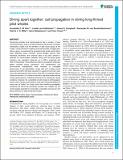Files in this item
Diving apart together : call propagation in diving long-finned pilot whales
Item metadata
| dc.contributor.author | Kok, Annebelle C.M. | |
| dc.contributor.author | van Kolfshoten, Lisette | |
| dc.contributor.author | Campbell, James A. | |
| dc.contributor.author | von Benda-Beckmann, Alexander M. | |
| dc.contributor.author | Miller, Patrick J.O. | |
| dc.contributor.author | Slabbekoorn, Hans | |
| dc.contributor.author | Visser, Fleur | |
| dc.date.accessioned | 2021-05-26T23:41:17Z | |
| dc.date.available | 2021-05-26T23:41:17Z | |
| dc.date.issued | 2020-05-27 | |
| dc.identifier | 268344393 | |
| dc.identifier | 41be24d4-b4f0-4993-8ad5-9bd44a3b3dd1 | |
| dc.identifier | 85085538540 | |
| dc.identifier | 32321748 | |
| dc.identifier | 000541845400003 | |
| dc.identifier.citation | Kok , A C M , van Kolfshoten , L , Campbell , J A , von Benda-Beckmann , A M , Miller , P J O , Slabbekoorn , H & Visser , F 2020 , ' Diving apart together : call propagation in diving long-finned pilot whales ' , Journal of Experimental Biology , vol. 223 , no. 10 , jeb207878 . https://doi.org/10.1242/jeb.207878 | en |
| dc.identifier.issn | 0022-0949 | |
| dc.identifier.uri | https://hdl.handle.net/10023/23260 | |
| dc.description | This research was funded by Office of Naval Research awards [N00014-08-1-0984, N00014-10-1-0355, N00014-15-1-2341], the Dutch Royal Navy (Koninklijke Nederlandse Marine) and the Norwegian Navy (Forsvarets Forskningsinstitutt – FFI). | en |
| dc.description.abstract | Group-living animals must communicate to stay in contact. In long-finned pilot whales, there is a trade-off between the benefits of foraging individually at depth and the formation of tight social groups at the surface. Using theoretical modelling and empirical data of tagged pairs within a group, we examined the potential of pilot whale social calls to reach dispersed group members during foraging periods. Both theoretical predictions and empirical data of tag pairs showed a potential for communication between diving and non-diving group members over separation distances up to 385 m (empirical) and 1800 m (theoretical). These distances match or exceed pilot whale dive depths recorded across populations. Call characteristics and environmental characteristics were analysed to investigate determinants of call detectability. Longer calls with a higher sound pressure level (SPL) that were received in a quieter environment were more often detected than their shorter, lower SPL counterparts within a noisier environment. In a noisier environment, calls were louder and had a lower peak frequency, indicating mechanisms for coping with varying conditions. However, the vulnerability of pilot whales to anthropogenic noise is still of concern as the ability to cope with increasing background noise may be limited. Our study shows that combining propagation modelling and actual tag recordings provides new insights into the communicative potential for social calls in orientation and reunion with group members for deep-diving pilot whales. | |
| dc.format.extent | 11 | |
| dc.format.extent | 1137595 | |
| dc.language.iso | eng | |
| dc.relation.ispartof | Journal of Experimental Biology | en |
| dc.subject | Active space | en |
| dc.subject | Communication | en |
| dc.subject | Contact call | en |
| dc.subject | Globicephala melas | en |
| dc.subject | Noise | en |
| dc.subject | Odontocete | en |
| dc.subject | QH301 Biology | en |
| dc.subject | Ecology, Evolution, Behavior and Systematics | en |
| dc.subject | Physiology | en |
| dc.subject | Aquatic Science | en |
| dc.subject | Animal Science and Zoology | en |
| dc.subject | Molecular Biology | en |
| dc.subject | Insect Science | en |
| dc.subject | NDAS | en |
| dc.subject.lcc | QH301 | en |
| dc.title | Diving apart together : call propagation in diving long-finned pilot whales | en |
| dc.type | Journal article | en |
| dc.contributor.sponsor | Office of Naval Research | en |
| dc.contributor.institution | University of St Andrews. School of Biology | en |
| dc.contributor.institution | University of St Andrews. Sea Mammal Research Unit | en |
| dc.contributor.institution | University of St Andrews. Scottish Oceans Institute | en |
| dc.contributor.institution | University of St Andrews. Institute of Behavioural and Neural Sciences | en |
| dc.contributor.institution | University of St Andrews. Centre for Social Learning & Cognitive Evolution | en |
| dc.contributor.institution | University of St Andrews. Bioacoustics group | en |
| dc.contributor.institution | University of St Andrews. Marine Alliance for Science & Technology Scotland | en |
| dc.identifier.doi | https://doi.org/10.1242/jeb.207878 | |
| dc.description.status | Peer reviewed | en |
| dc.date.embargoedUntil | 2021-05-27 | |
| dc.identifier.url | https://jeb.biologists.org/content/223/10/jeb207878.supplemental | en |
| dc.identifier.grantnumber | N00014 08 1 0984 | en |
This item appears in the following Collection(s)
Items in the St Andrews Research Repository are protected by copyright, with all rights reserved, unless otherwise indicated.

